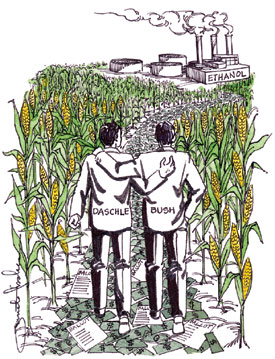What's new in production
Ethanol mythanol. First and foremost, forget about the truth. There is none. Just opinions and distortions. The ethanol issue has become so politicized that I’m reminded of Dante’s sign at the Gate, "Abandon all hope [of truth], ye who enter here." There are at least 50 farming co-ops, state corn-growers associations, political action committees, methanol organizations and so on involved in this controversy, and they have pummeled the media with their own spin, be it pro or con, such that facts are impossible to discern. This is sort of a civil war: the Midwest corn-growing region versus the East and West Coasts. That being said, here’s this editor’s take on it, in the form of three myths about ethanol. Myth 1. Ethanol will not lessen our dependence on foreign oil. Ethanol will lessen U.S. dependence on foreign oil. The same could be said for Europe, Brazil and other importers that are investing heavily in ethanol production. The U.S. goal is to increase ethanol production from the current 1.4% of transportation fuel supply to about 4%. While 4% is small, it is not insignificant. However, whether it ultimately matters or not is questionable, since, by itself, ethanol will barely slow the seemingly inevitable growth in U.S. oil imports, and there is no plan to stop or reverse that. To reverse the long-term trend and set an oil-import goal of say, less than 20% of demand within 30 years – down from the current 56% or so – would require foresight, planning and leadership that no politician seems to have. It would need many "4% solutions," such as: allowing drilling in ANWR and offshore the East and West Coasts; increasing average motor fuel economy even a few mpg; seriously investing in wind, solar, geothermal and ocean-energy power generation; natural-gas based transportation fuels, including LNG-, CNG-, and GTL-based infrastructure; fuel cells; hybrid electric vehicles; high-efficiency lighting; next-generation nuclear power; and various other proven technologies. Myth 2. Ethanol is good for the environment. Despite Archer Daniel Midland’s advertising, this is debatable, and has especially confused environmentalists. When California asked EPA for an exemption from the oxygenate mandate, EPA’s response was that whether ethanol benefits air quality is not important, rather, states must clearly prove that it degrades air quality to be exempted from mandatory oxygenate laws. Ethanol might benefit air quality, on balance, slightly. Its use increases NOx, but decreases CO; many other factors are unclear. On the plus side, it is much less harmful than MTBE in soil and surface water. However, creating it is not environmentally benign. Ethanol plants generally use coal as a heat source for ethanol conversion, since burning ethanol is too expensive. Also, the process itself creates pollution, and recent sampling indicates that most ethanol plants are in violation of EPA air-quality standards to an obscene degree, which is ironic in that the "new" EPA is playing a key role in furthering ethanol use. The "downwinders" from these plants consider them pollution monsters. Finally, agricultural runoff is poorly regulated – often not at all. The so-called "dead zone" in the Gulf of Mexico is a 6,500-sq.-mi lifeless patch of ocean. Nutrients associated with agricultural runoff are believed to be a key cause.
Myth 3. Government subsidies will not help ethanol eventually become profitable. Although the future is unknowable, genetics and other advances will likely make ethanol a profitable venture someday. Ethanol, like all commodities, including oil, timber, coal, etc., is being produced more efficiently. Government subsidies – now about 1/3 of the cost of ethanol production – will likely need to continue for another 15 to 20 years. This is in addition to more than 20 years already invested. So, if ethanol production is not profitable, environmentally questionable and will barely benefit energy security, why is it being shoved down the American people’s throats? It’s about payola and votes, that is, what politicians get when they bring billions of dollars back to their districts. Money is the politician’s drug of choice, and they know that a certain percentage will be returned to them in campaign contributions. The farm bill was pork-barrel legislation taken to new heights, and it was breathtaking in its scope. The $190-billion (10-yr) budget buster comes at a time when the U.S. is deficit spending. Pitifully little will go toward helping small family-owned farms. Now the new Renewable Fuel Standard (a.k.a. ethanol) is working its way through the legislature. You could write, phone or email your congressman or senator if you are so motivated. I have. But – and forgive the cynicism – I doubt that it will help. The leadership of both parties is behind the move to ethanol. Editor’s note. I’ve enjoyed writing this column for the last four years, but this will be my last. Robert Snyder will be writing it beginning next month. I’m sure that you will enjoy Bob’s columns as much as I do.
|
- What's new in production (February 2024)
- Prices and governmental policies combine to stymie Canadian upstream growth (February 2024)
- U.S. operators reduce activity as crude prices plunge (February 2024)
- U.S. producing gas wells increase despite low prices (February 2024)
- U.S. drilling: More of the same expected (February 2024)
- U.S. oil and natural gas production hits record highs (February 2024)
- Applying ultra-deep LWD resistivity technology successfully in a SAGD operation (May 2019)
- Adoption of wireless intelligent completions advances (May 2019)
- Majors double down as takeaway crunch eases (April 2019)
- What’s new in well logging and formation evaluation (April 2019)
- Qualification of a 20,000-psi subsea BOP: A collaborative approach (February 2019)
- ConocoPhillips’ Greg Leveille sees rapid trajectory of technical advancement continuing (February 2019)




